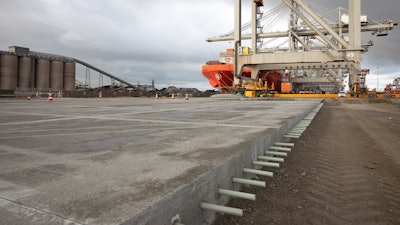Advanced Composites for Resilient and Lightweight Building And Construction
Advanced Composites for Resilient and Lightweight Building And Construction
Blog Article
Unlocking the Ecological Advantages of Recycled Composites in Building and Style
In the realm of construction and design, the usage of recycled composites holds substantial assurance for improving sustainability practices and minimizing ecological impact (composites). By integrating these ingenious products, there is a possible to deal with vital issues such as waste reduction, energy conservation, and a decrease in carbon impact. The change towards a more sustainable future in these markets pivots on opening the complete possibility of recycled composites. This discussion will certainly check out the complex advantages and challenges connected with incorporating recycled compounds into building and layout, offering a glimpse into the transformative opportunities that exist in advance.

Ecological Influence Decrease
The reduction of ecological effect with the usage of recycled composites in construction and design plays an important duty in lasting techniques. By integrating recycled composites into structure materials, the construction sector can considerably lower its carbon footprint and add to an extra eco-friendly future. These sustainable products, made from repurposed plastics, timber fibers, or various other recycled components, provide a viable option to conventional building and construction materials without jeopardizing on top quality or longevity.
Recycled compounds aid draw away waste from landfills and reduce the requirement for removing resources, therefore conserving natural sources. In addition, the manufacturing process of these composites usually eats much less energy and produces fewer greenhouse gases compared to generating virgin products (composites). This change in the direction of utilizing recycled compounds not just lessens ecological injury yet additionally promotes a circular economic situation by urging the reuse of materials that would certainly or else be disposed of
Waste Reduction
With a concentrate on minimizing waste in building and construction and style, the integration of recycled composites offers a lasting service to lower ecological influence. Waste minimization is a critical aspect of sustainable methods, and making use of recycled compounds offers an opportunity to achieve this objective effectively. By utilizing products that have currently offered their first function, such as recycled plastics or reclaimed wood fibers, the building and design sectors can considerably reduce the quantity of waste created and sent out to garbage dumps.
Recycled composites have the prospective to divert substantial quantities of waste from traditional disposal approaches, adding to an extra round economic situation where resources are utilized effectively. In addition, the production process of recycled composites often consumes less power and generates less exhausts contrasted to virgin products, even more decreasing the environmental footprint of construction and design tasks.
Applying waste reduction methods with the consolidation of recycled composites not just aids in saving natural deposits yet additionally advertises a more sustainable strategy to structure and developing for a greener future.
Energy Preservation
Incorporating recycled compounds not just decreases waste in building and layout yet additionally plays an important duty in improving power preservation methods within the industry. The use of recycled compounds in construction can dramatically add to power preservation via various means. By promoting the use of recycled compounds in building and construction and layout, the sector can make substantial strides in the direction of accomplishing energy effectiveness and decreasing its carbon footprint, ultimately adding to an extra lasting built setting.
Carbon Footprint Decrease
Enhancing sustainability practices with the usage of recycled composites in building and design substantially minimizes the carbon impact of the sector. By integrating recycled products into the manufacturing of composites, the requirement for virgin sources reduces, resulting in lower energy intake and greenhouse gas discharges associated with traditional production processes. This decrease in carbon impact is essential in combating climate change and advertising a much more environmentally pleasant method to construction and design.
In addition, the use of recycled composites additionally helps in drawing away waste from garbage dumps, thus mitigating the ecological effect of disposal and promoting a round economy. The carbon impact reduction achieved through the fostering of recycled composites aligns with the worldwide push in the direction of lasting methods and the reduction of industrial exhausts. It showcases a commitment to liable resource management and a change in the direction of greener options in the building and design sectors. Inevitably, by focusing on the assimilation of recycled like this compounds, the industry can make considerable strides in decreasing its carbon footprint and adding to a more lasting future.
Lasting Future
The assimilation of recycled compounds in construction and layout not only addresses immediate ecological worries however also lays a strong foundation for a lasting future in the sector. By including recycled composites into building products and items, the building and construction and style fields can considerably reduce their dependence on virgin resources, resulting in a more circular economy. This change towards sustainability is critical for alleviating the ecological influence of standard building practices, which commonly result in high degrees of waste generation and resource deficiency.

Conclusion
To conclude, recycled composites use substantial environmental benefits in building and style by lowering environmental influence, reducing waste, preserving energy, reducing carbon footprint, and promoting a sustainable future. Welcoming the usage of recycled compounds can add to an extra environmentally-friendly method to structure and design, ultimately leading to a much more lasting and greener future for all.
The decrease of ecological influence through the use of recycled composites in building and style plays a crucial role in lasting methods.With a focus on lessening waste in building and layout, the combination of recycled composites supplies a lasting solution to reduce ecological effect. By advertising the use of recycled compounds in construction and style, the industry can make significant strides in the direction of achieving power effectiveness and reducing its carbon impact, ultimately adding to a more sustainable constructed atmosphere.

Report this page